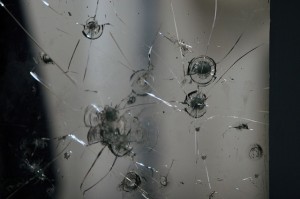The story behind bulletproof glass
Laminated glass is used in a number of safety and security applications, where shattered glass would be very dangerous. In bulletproof glass, the glass layers tend to flatten a projectile, while the polycarbonate layers deform on impact, which diffuses the projectile’s energy and prevents it from traveling through the glass.
In addition, various alternative laminates can be combined with glass to give bulletproof glass different safety characteristics. For example, polycarbonate layers could be laminated between glass layers to improve the material’s ability to stop projectiles. Acrylic could also be used in alternating layers between glass to create a different level of stopping power.
Different firearms expel bullets at different velocities. The velocity of the projectile determines its penetration ability, so bulletproof glass is designed in various thicknesses to protect against specific types of firearms. The protection offered by the glass depends upon its construction. Glass designed to protect against handguns may not perform well against rifles. Bulletproof glass can also be designed to offer protection in one direction only. With “one-way” bulletproof glass, an attacker would not be able fire through the glass, but someone on the “safe” side of the glass could fire through it unimpeded.
Bulletproof glass is not only useful for situations where security is important. It can also perform well against catastrophic weather events like hurricanes. It is also exceptionally scratch resistant. One disadvantage of bulletproof glass is that it significantly reduces the transmission of visible light. In addition, over time, UV light exposure can damage the laminated layers of polycarbonate or acrylic. UV light damage can cause the intermediate layers to discolor or cloud, further reducing the transmission of visible light.
Glassprimer™ glass paint is a specialized glass coating that bonds permanently to glass surfaces. GlassPrimer also makes a glass surface molecular activator that is designed to work with UV-inkjet glass printing processes. For more information about Glassprimer™ glass paint, please visit the rest of our site. If you’d like to purchase Glassprimer™ glass paint, please visit our online store .
Photo Credit: Pulpolux, via Flickr.com

